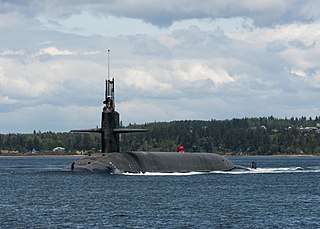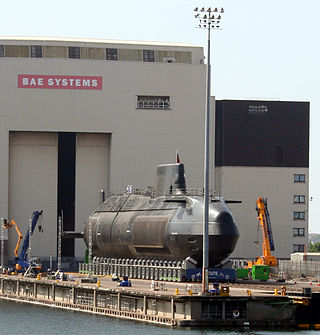
The Benjamin Franklin-class submarine was a group of US ballistic missile submarines that were in Navy service from the 1960s–2000s. The class was an evolutionary development from the earlier James Madison class of fleet ballistic missile submarine. Having quieter machinery and other improvements, it is considered a separate class. A subset of this class is the re-engineered 640 class starting with USS George C. Marshall. The primary difference was that they were built under the new SUBSAFE rules after the loss of USS Thresher, earlier boats of the class had to be retrofitted to meet SUBSAFE requirements. The Benjamin Franklin class, together with the George Washington, Ethan Allen, Lafayette, and James Madison classes, composed the "41 for Freedom" that was the Navy's primary contribution to the nuclear deterrent force through the late 1980s. This class and the James Madison class are combined with the Lafayettes in some references.

The Ohio class of nuclear-powered submarines includes the United States Navy's 14 ballistic missile submarines (SSBNs) and its four cruise missile submarines (SSGNs). Each displacing 18,750 tons submerged, the Ohio-class boats are the largest submarines ever built for the U.S. Navy. They are the world's third-largest submarines, behind the Russian Navy's Soviet-designed 48,000-ton Typhoon class and 24,000-ton Borei class. At 20 Trident II missiles apiece, Ohio-class boats carry just as many missiles, if not more, than either the Borei class or the recently deactivated Typhoon class (20).

The Seawolf class is a class of nuclear-powered, fast attack submarines (SSN) in service with the United States Navy. The class was the intended successor to the Los Angeles class, and design work began in 1983. A fleet of 29 submarines was to be built over a ten-year period, but that was reduced to 12 submarines. The end of the Cold War and budget constraints led to the cancellation of any further additions to the fleet in 1995, leaving the Seawolf class limited to just three boats. This, in turn, led to the design of the smaller Virginia class. The Seawolf class cost about $3 billion per unit, making it the most expensive United States Navy fast attack submarine and second most expensive submarine ever, after the French Triomphant-class nuclear-powered ballistic missile submarines.

The Virginia class, or the SSN-774 class, is the latest class of nuclear-powered cruise missile fast-attack submarines in service with the United States Navy. Designed by General Dynamics Electric Boat (EB) and Huntington Ingalls Industries, the Virginia class incorporates the latest in stealth, intelligence gathering, and weapons systems.

A ballistic missile submarine is a submarine capable of deploying submarine-launched ballistic missiles (SLBMs) with nuclear warheads. The United States Navy's hull classification symbols for ballistic missile submarines are SSB and SSBN – the SS denotes submarine, the B denotes ballistic missile, and the N denotes that the submarine is nuclear powered. These submarines became a major weapon system in the Cold War because of their nuclear deterrence capability. They can fire missiles thousands of kilometers from their targets, and acoustic quieting makes them difficult to detect, thus making them a survivable deterrent in the event of a first strike and a key element of the mutual assured destruction policy of nuclear deterrence.

USS Ohio (SSBN-726/SSGN-726), the lead boat of her class of nuclear-powered fleet ballistic missile submarines (SSBN), is the fourth vessel of the United States Navy to be named for the U.S. state of Ohio. She was commissioned with the hull designation of SSBN-726, and with her conversion to a guided missile submarine she was re-designated SSGN-726.

USS Louisiana (SSBN-743) is the 18th and last ship of the United States Navy's Ohio class of nuclear-powered fleet ballistic missile submarines. She carries Trident ballistic missiles and has been in commission since 1997. She is the fourth commissioned ship to bear the name of the U.S. state of Louisiana.

USS Maine (SSBN-741) is a United States Navy Ohio-class ballistic missile submarine in commission since 1995. She is the fourth U.S. Navy ship authorized, and the third commissioned, to be named in honor of the state of Maine. She has the capability to carry 24 nuclear armed Trident ballistic missiles.

The George Washington class was a class of nuclear-powered ballistic missile submarines deployed by the United States Navy. George Washington, along with the later Ethan Allen, Lafayette, James Madison, and Benjamin Franklin classes, comprised the "41 for Freedom" group of submarines that represented the Navy's main contribution to the nuclear deterrent force through the late 1980s.

USS Michigan (SSBN-727/SSGN-727) is an Ohio-class nuclear-powered guided missile submarine (SSGN), converted from a ballistic missile submarine (SSBN), that is part of the United States Navy. She is the third vessel to bear the name of the U.S. state of Michigan.

USS Alabama (SSBN-731) is the sixth Ohio-class nuclear-powered ballistic missile submarine, and the seventh United States vessel to be named for the state of Alabama. The boat's motto duplicates the state's motto, Audemus Jura Nostra Defendere.

A nuclear submarine is a submarine powered by a nuclear reactor, but not necessarily nuclear-armed. Nuclear submarines have considerable performance advantages over "conventional" submarines. Nuclear propulsion, being completely independent of air, frees the submarine from the need to surface frequently, as is necessary for conventional submarines. The large amount of power generated by a nuclear reactor allows nuclear submarines to operate at high speed for long periods, and the long interval between refuelings grants a range virtually unlimited, making the only limits on voyage times being imposed by such factors as the need to restock food or other consumables.

USS Kentucky (SSBN-737) is a United States Navy Ohio-class ballistic missile submarine which has been in commission since 1991. She is the third U.S. Navy ship to be named for Kentucky, the 15th state.

USS Wyoming (SSBN-742) is a United States Navy Ohio-class ballistic missile submarine which has been in commission since 1996. She is the fourth US Navy ship to be named USS Wyoming, although it was only the third named after the state of Wyoming.

USS Columbia (SSN-771) is the 21st flight III, or Improved (688i) Los Angeles-class attack submarine of the United States Navy. Commissioned in 1995, the submarine is assigned to Submarine Squadron 7 and homeported in Joint Base Pearl Harbor-Hickam.

The Borei class, alternate transliteration Borey, Russian designation Project 955 Borei and Project 955A Borei-A, are a series of nuclear-powered ballistic missile submarines being constructed by Sevmash for the Russian Navy. The class is projected to replace the Soviet-era Delta III, Delta IV and Typhoon classes in Russian Navy service.

The Columbia-class is an upcoming class of nuclear-powered ballistic missile submarines designed to replace the Ohio-class of the United States Navy. Construction of the first submarine began on 1 October 2020. She is scheduled to enter service in 2031.
USS Wisconsin (SSBN-827) will be the second Columbia-class submarine ballistic missile submarine. She is the third vessel of the United States Navy to be named after the state of Wisconsin, the last of which was the Iowa-class battleship, USS Wisconsin (BB-64), decommissioned in 1991 and stricken from the Naval Vessel Register in 2006.
The SSN(X) program, also known as the Next-Generation Attack Submarine program, is a United States Navy program to develop a class of nuclear attack submarines to succeed its Virginia-class and Seawolf-class attack submarines. The SSN(X) program is still in the early stages of development and no official details have been released about its design or capabilities.
















